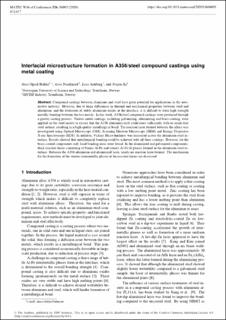| dc.contributor.author | Bakke, Aina Opsal | |
| dc.contributor.author | Nordmark, Arne | |
| dc.contributor.author | Arnberg, Lars | |
| dc.contributor.author | Li, Yanjun | |
| dc.date.accessioned | 2020-11-10T13:01:04Z | |
| dc.date.available | 2020-11-10T13:01:04Z | |
| dc.date.created | 2020-11-05T15:18:15Z | |
| dc.date.issued | 2020 | |
| dc.identifier.issn | 2261-236X | |
| dc.identifier.uri | https://hdl.handle.net/11250/2687126 | |
| dc.description.abstract | Compound castings between aluminum and steel have great potential for applications in the automotive industry. However, due to large differences in thermal and mechanical properties between steel and aluminum, and the formation of stable aluminum oxides at the interface, it is difficult to form high strength metallic bonding between the two metals. In this work, A356/steel compound castings were produced through a gravity casting process. Various metal coatings, including galvanizing, aluminizing and brass-coating, were applied on the steel inserts to ensure that the A356 aluminum melt could react sufficiently with an oxide-free steel surface, resulting in a high-quality metallurgical bond. The reaction layer formed between the alloys was investigated using Optical Microscopy (OM), Scanning Electron Microscopy (SEM) and Energy Dispersive X-ray Spectroscopy (EDS). In addition, Vickers Micro-hardness was measured across the aluminum-steel interface. Results showed that metallurgical bonding could be achieved with all three coatings. However, for the brass-coated components only local bonding areas were found. In the aluminized and galvanized components, thick reaction layers consisting of binary Al-Fe and ternary Al-Fe-Si phases formed in the aluminum-steel interface. Between the A356 aluminum and aluminized layer, nearly no reaction layer formed. The mechanism for the formation of the various intermetallic phases at the reaction layers are discussed. | en_US |
| dc.language.iso | eng | en_US |
| dc.publisher | EDP Sciences | en_US |
| dc.rights | Navngivelse 4.0 Internasjonal | * |
| dc.rights.uri | http://creativecommons.org/licenses/by/4.0/deed.no | * |
| dc.subject | steel | en_US |
| dc.subject | castings | en_US |
| dc.subject | Optical Microscopy | en_US |
| dc.subject | Scanning Electron Microscopy | en_US |
| dc.subject | Energy Dispersive X-ray Spectroscopy | en_US |
| dc.subject | Vickers Micro-hardness | en_US |
| dc.title | Interfacial microstructure formation in A356/steel compound castings using metal coating | en_US |
| dc.type | Peer reviewed | en_US |
| dc.type | Journal article | en_US |
| dc.description.version | publishedVersion | en_US |
| dc.rights.holder | © 2020 The Authors, published by EDP Sciences | en_US |
| dc.source.pagenumber | 9 | en_US |
| dc.source.volume | 326 | en_US |
| dc.source.journal | MATEC Web of Conferences | en_US |
| dc.identifier.doi | https://doi.org/10.1051/matecconf/202032606005 | |
| dc.identifier.cristin | 1845357 | |
| dc.source.articlenumber | 06005 | en_US |
| cristin.ispublished | true | |
| cristin.fulltext | preprint | |
| cristin.qualitycode | 1 | |

